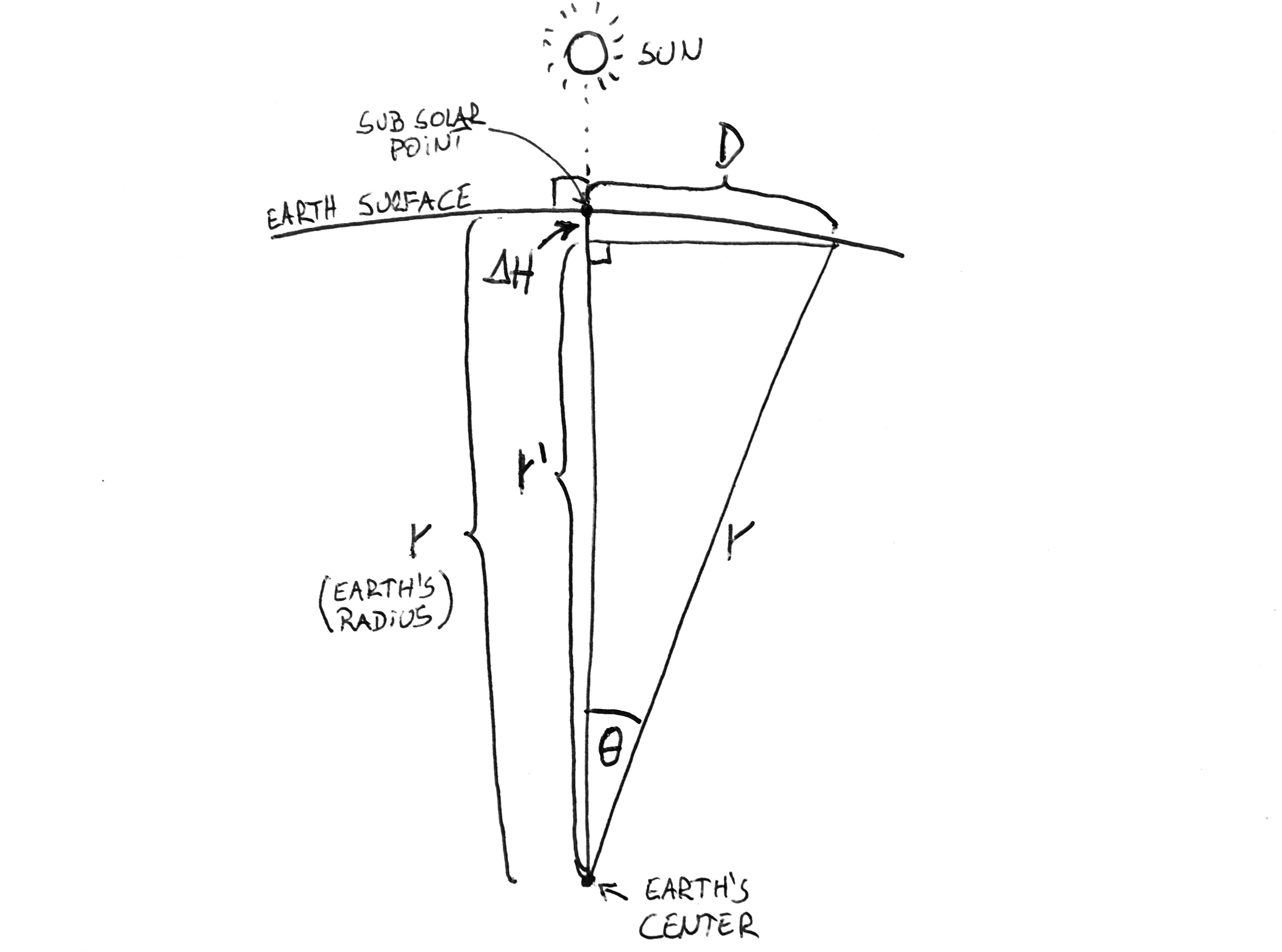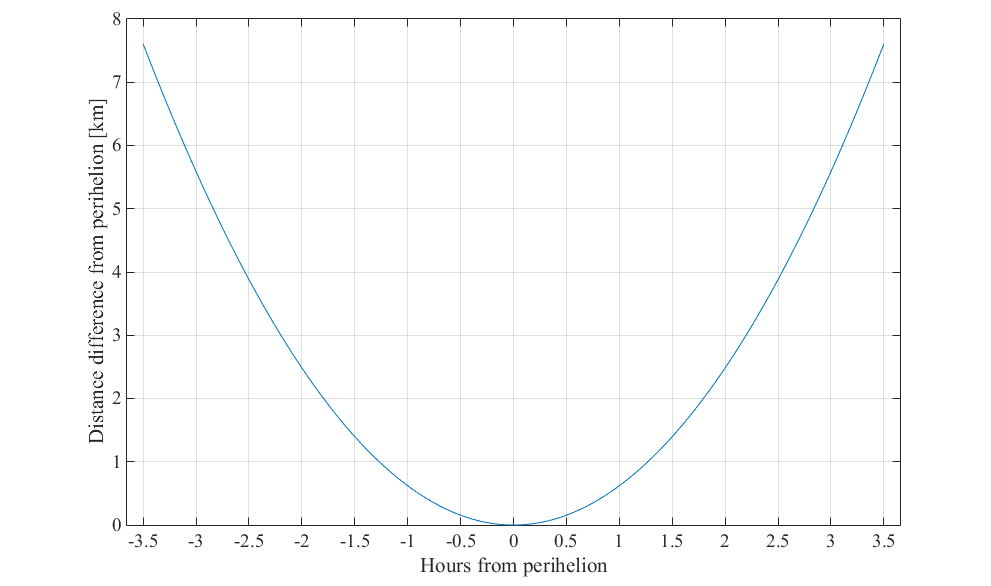This is an interesting question, but it lacks a key factor that is crucial to the answer: TIME.
The point on Earth closest to the Sun varies through time, so the question can be asked about any moment in time, or over periods of time. Let's analyze the factors involved.
At any given moment in time, the point on Earth's surface that is closest to the Sun is what is called the “subsolar point”. This point corresponds to the point on the surface that intersects the imaginary line that connects the center of the Earth to the center of the Sun. In other words, the subsolar point correspond to the point on Earth surface where the sunlight hits the Earth perpendicular to the ground, therefore, a vertical object would project no shadow.

(image from Wikipedia: subsolar point)
The longitude of the subsolar point corresponds to that of the meridian experiencing solar noon. Over Greenwich (longitude 0°) that happens at the actual noon, and as the Earth rotates 15° every hour, that will happen one our later (at 13:00 h UTC) at longitude 15° W, two hours later (at 14:00 h UTC) at longitude 30° W, and so on. In general terms, you can use the following formula for the subsolar point longitude ($\text{SSP}_{\text{long}}$).
$\text{SSP}_{\text{long}} = \left(\text{UTC} -12\right)*15°$
This is a simplified formula, but accurate enough for our purpose. Let's take as an example the following date
July 20, 1969, at 20:17 UTC
In that moment, the longitude of the subsolar point was 124° 15' West:
$(20+(17/60)-12)*15°=124.25°=124°15'$
Finding the latitude of the subsolar point is a bit more complicated, we need to know the declination of the Sun. Declination is the equivalent of latitude for celestial coordinates. For that, use a formula, a table, or a online calculator like the NOAA Solar Position Calculator.
Just enter the date, and even that the location doesn't matter here, we need to select “Enter Lat/Long -->” to be allowed to enter the offset to UTC as 0, otherwise the time won't be interpreted as UTC time.
From there we can find that the solar declination for our example date is 20.58° (20° 34') which corresponds to the latitude of the subsolar point: 20° 34' North.
Therefore, on July 20, 1969, at 20:17 UTC, the subsolar point was at 20° 34' N, 124° 15' W, which is somewhere between Mexico and Hawaii. That was the point on Earth closest to the Sun at that moment.
Now, what would happen if there were a very tall mountain close to the subsolar point? Would that mountain be closer to the Sun?
The answer is: probably. It depends on how far and how much higher it is relative to the subsolar point.
We can do a quick calculation based on the following diagram (in this approximation we assume that Earth is spherical, that the sun is infinitely far away and other simplifications)

From there we have
$r-r'=\Delta H$
$D = r ~ \theta$ ($\theta$ in radians)
$\frac{r'}{r}=\cos(\theta)$
After some algebra you can write that the extra height $\Delta H$ needed to be as close to the Sun as the subsolar point is
$\Delta H = r \left(1-\cos\left(\frac{D}{r}\right)\right)$
Where $D$ is the distance and $r$ is Earth's radius (in this case makes sense to use the equatorial radius of 6378.1 km)
If we plot this equation we get the following

(the vertical axis is logarithmic)
We can see that around 10 km away from the subsolar point, ~10 meters are enough to be closer than it to the Sun. ~30 meters at 20 km, ~800 meters at 100 km, ~3,000 m at 200 km, and if you go further than 340 km, not even Mount Everest will get you closer to the Sun.
So, the closest point to the Sun will be whatever geographical feature that maximizes the value $\text{Altitude}-\Delta H$, where $\text{Altitude}$ is the altitude of the geographical feature. Let's call that point “proxisolar” point. I just made up that name, but it will be handy for the following discussion.
Now that we understand the basis to establish what is the closest point to the Sun at a given moment, we can tackle the question that probably most people meant when asking this question:
What is the point on Earth that gets closest to the Sun over a year?
The most important fact to keep in mind, is that the variations of the distance between the Earth and the Sun over the year dwarf any topographical feature and even the diameter of the Earth itself. Earth’s distance from the Sun (center-to-center) varies from 147,098,074 km at perihelion (closest) to 152,097,701 km at aphelion (most distant). Therefore, the difference is 5 million kilometers!.
The perihelion happens around January 4th, when the solar declination is about -23°, therefore, the latitude of the subsolar point is around 23° South. That rules out Chimborazo, Cayambe and Everest, because they are too far to be the “proxisolar” point. In contrast, Sairecabur (5,971 m at 22.72° S) and Licancabur (5,916m at 22.83° S) are reasonable contestants.
The problem is that the perihelion happens on different days of the year and at different times of the day every year, so the point that gets closest to the Sun on a given year is just the one that happen to be the “proxisolar point” at the time of the Perihelion.
People who argues that Sairecabur or Licancabur are the points that get closer to the Sun, are implicitly assuming that the distance Earth-Sun doesn't vary much during the day of the perihelion. Therefore, the extra elevation of these mountains allows them to get closer to the Sun during that day. Unfortunately, that assumption is completely wrong. Let's see why:
An approximation of the distance Earth-Sun can be obtained from the following formula
$d = \frac{a(1-e^2)}{1+e \cos\left(\text{days}\frac{360}{365.25}\right)}$
Where $a$ is the semi-major axis of Earth's orbit, $e$ is the eccentricity, and $\text{days}$ is the number of days elapsed since the perihelion. To see the simplifications behind this equation look here (note that the conversion factor 360/365.25 is erroneously inverted in that link, thanks @PM2Ring for spotting that).
If you solve the above equation for the perihelion and for one day before/after it, you will get that the difference is 358 km, and for half a day you get 89 km. Therefore, if the subsolar point happens to be on the opposite side of the Earth than, let's say, Licancabur volcano, this volcano would need to be 89 km higher that the subsolar point to get closer than it to the Sun that year. 89 kilometers!
Therefore, we can discard the idea that a given mountain could be the point that gets closer to the Sun on EVERY year.
If we plot the above equation with distances relative to the perihelion we get the following (using $a$ and $e$ from here)

Here we can see, that if the perihelion happens a bit more than 3 hours before or after the solar noon at Licancabur, the ~6,000 m of elevation advantage would not be enough to get closer to the Sun than the subsolar point at the perihelion, even if such point is at sea level.
Note that three hours corresponds to 45° in Longitude, which at that approximate latitude corresponds to approximately 4,600 km.
Therefore, it can be argued that Licancabur is the point on Earth that has more chances to be the closest to the Sun in an arbitrary year. But in a given year, it might or might not be the closest depending on where the subsolar point is at the moment of the perihelion.
Finally, it is important to note that the distance Earth-Sun at the perihelion varies widely from year to year. If you look at this table of perihelions between years 2001 and 2100, you will see that perihelions often vary by several thousand of kilometers.
Therefore, for example between years 2001 and 2100, the closest perihelion by far is the perihelion of next year (2020), and it will happen when the subsolar point is in the middle of the Indian ocean, about 12,700 km away from Licancabur and Sairecabur volcanoes. Therefore, the point that will be closest to the Sun this century will be one in the middle of the Indian ocean about 320 km south of Rodrigues Island.
Said this, the question of which point on Earth will get closest to the Sun depends on the period of time on which it is considered. For each year, each century and any other arbitrary period of time, the answer will be different.




